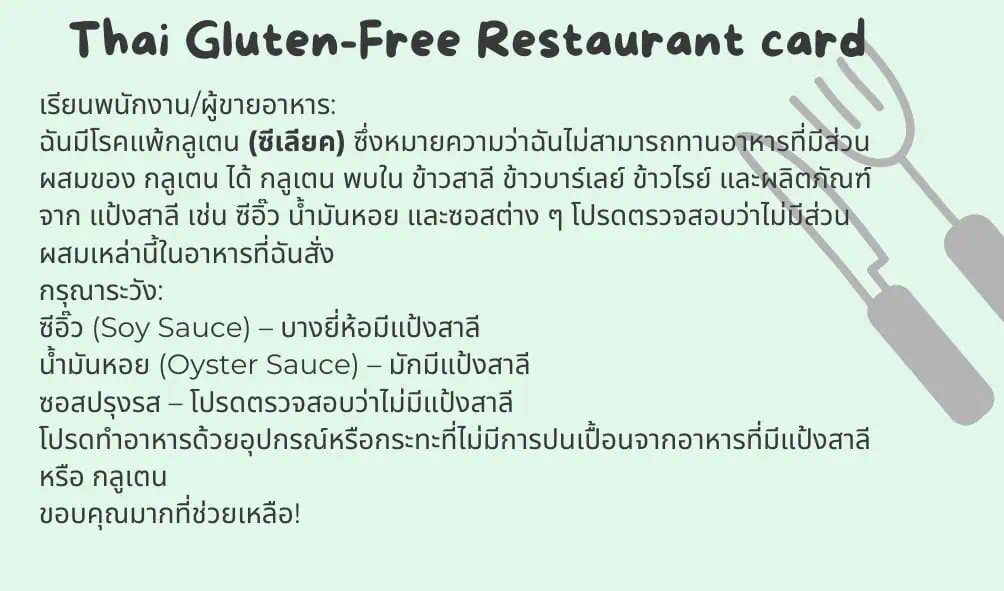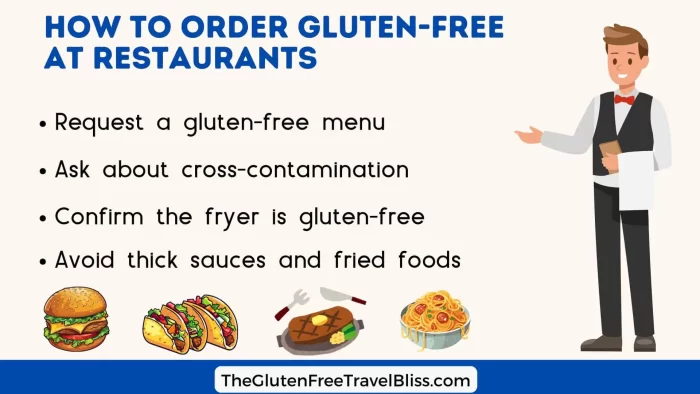How to Find Celiac Safe Restaurants While Traveling in 2025
When you or your child has celiac disease, eating out at celiac safe restaurants while traveling can quickly turn from exciting to stressful. Restaurants may advertise “gluten-free” options, but are they truly safe? This guide helps you vet restaurants abroad, ask the right questions, and eat fearlessly, without risking your loved one’s health.
Essential Questions to Ask Restaurants About Gluten-Free Safety
Asking “Do you have gluten-free options?” isn’t enough. To ensure true celiac safety, dig deeper with these critical questions:
- Is there a dedicated gluten-free prep area? Shared cutting boards or countertops can spell trouble. A celiac-safe kitchen has separate spaces for gluten-free dishes.
- Are fryers used exclusively for gluten-free foods? Fries cooked in the same fryer as breaded chicken are a no-go. Ask if they have a separate fryer or avoid fried foods altogether.
- Do sauces, broths, or spices contain hidden gluten? Hidden gluten can hide in soy sauce, spice blends, or even “natural flavors.” Ask if they use certified gluten-free ingredients.
- Is the staff trained on cross-contamination? A server’s “sure, it’s gluten-free” doesn’t cut it. Confirm if the kitchen staff understands celiac needs, like using clean utensils or gloves.
- Can they walk you through the preparation process? A confident chef can explain exactly how your meal is made, from chopping to plating.
I learned this the hard way in Barcelona. A charming tapas bar swore their patatas bravas were gluten-free, but when I asked about the fryer, the server’s blank stare said it all. Lesson learned: dig deeper.
💡 Pro Tip: Call ahead during off-peak hours to speak with a manager or chef for a more detailed answer.
Checklist to Vet Gluten-Free Restaurants for Celiac Safety
Use this quick checklist to evaluate any restaurant:
- ✅ Separate prep space
- ✅ Dedicated fryer or no fried foods
- ✅ Certified gluten-free ingredients
- ✅ Staff understands cross-contamination
- ✅ A manager or chef can explain dish prep
How to Spot Red Flags in ‘Gluten-Free’ Restaurants Abroad
Some responses may sound reassuring, but aren’t. Watch for these red flags:
- “I think it’s gluten-free.” ❌ Red flag! “I think” means they don’t know. Ask for a manager or chef to confirm.
- “We can make it gluten-free.” ❌ This sounds promising but often means they’ll just skip the bun or croutons. Probe further: “How do you prevent cross-contamination?”
- “Our kitchen is very clean!” ❌ Cleanliness is great, but it doesn’t address shared fryers or cutting boards. Ask for specifics on gluten-free protocols.
- Staff appear hesitant or unsure. ❌ If the staff seems unsure or rushes to change the subject, trust your gut and consider dining elsewhere.
If you’re getting vague answers, trust your gut and walk away. In Lisbon, I once had a waiter proudly offer a “gluten-free” seafood paella, only to admit later that the stock might contain gluten. Always double-check, and don’t be afraid to walk away if the answers don’t add up.
Use Local Celiac Groups to Find Celiac Safe Restaurants Abroad
One of the best-kept secrets for celiac-safe travel? Local celiac groups. These communities, often found on Facebook, Reddit, or through national celiac societies, know the real deal. They’ve already vetted restaurants, so you don’t fall for tourist traps waving a “gluten-free” flag to lure you in.
Here’s how to leverage them:
- Check Celiac Society Websites: Many countries, like the UK (Coeliac UK), Italy (AIC in Italy) or Australia (Coeliac Australia), have directories of vetted restaurants. These are goldmines for safe dining.
- Search for Local Groups: Look for groups like “Celiac Italy” or “Gluten-Free Japan” on Facebook or platforms like Meetup. Reddit’s r/celiac or r/glutenfree often have region-specific threads too.
- Ask for Recommendations: Post a quick question like, “Heading to Paris, any celiac-safe restaurants with dedicated kitchens?” Locals will chime in with gems you won’t find on TripAdvisor.
These groups have vetted restaurants and offer priceless real-world advice.
How to Create a Detailed Gluten-Free Chef Card for Travel
You’ve probably heard of a celiac “chef card”, a translated card explaining your dietary needs. But a basic card saying, “I can’t eat gluten,” is like handing a chef a Post-it note and hoping for the best. Upgrade to a Detailed Chef Communication Card for real impact.
Here’s how to create one:
- Include Specifics: List what gluten is (wheat, barley, rye, and sometimes oats), emphasize cross-contamination risks, and mention hidden sources like sauces or broths.
- Translate Accurately: Use professional translation services or tools for precision. Include the local language and English for clarity.
- Add a Personal Touch: Start with a polite greeting, like “Dear Chef, I have celiac disease and would love to enjoy your amazing food safely.” Flattery opens doors.
- Request a Dialogue: Ask the chef to confirm the dish’s preparation or suggest safe options. This invites collaboration, not just compliance.
I used a card like this in Thailand, and the chef not only confirmed a safe dish but created a custom gluten-free curry just for me. A detailed card shows you’re serious and helps the kitchen take you seriously too.

Advice You Didn’t Know You Needed
Traveling as a celiac isn’t just about finding “gluten-free” restaurants, it’s about mastering the art of investigation. Here are a few extra tips you didn’t know you needed:
- Pack Backup Snacks: Even with the best planning, you might hit a snag. Keep certified gluten-free bars or snacks in your bag for emergencies.
- Time Your Meals Strategically: Dining early or late can mean less rushed staff, giving them time to focus on your needs.
- Learn Local Gluten Terms: In Italy, “senza glutine” is your friend. In Japan, it’s “guruten furī.” Knowing the local lingo helps you spot safe options on menus.
- Trust Your Instincts: If a restaurant feels off, maybe the staff dodges questions or the kitchen looks chaotic, don’t risk it. Your health is worth a short walk to the next spot.
Conclusion: Eat Fearlessly, Travel Freely
Traveling with celiac disease doesn’t mean you’re stuck eating sad salads in your hotel room. By asking the right questions, tapping into local celiac communities, and wielding a killer Chef Communication Card, you can uncover restaurants that are truly safe, not just “gluten-free” in name. From the bustling markets of Marrakech to the cozy bistros of Paris, the world is full of celiac-safe adventures waiting for you. So pack your checklist, channel your inner detective, and get ready to eat fearlessly.
Ready to plan your next gluten-free trip? Start by joining a local celiac group for your destination or crafting your own Chef Communication Card. Safe travels and bon appétit!
FAQs About Celiac Safe Restaurants And Dining Abroad
How do I find celiac-safe restaurants while traveling?
Join local celiac Facebook groups or check celiac society directories. Ask restaurants directly about their safety practices.
What questions should I ask a restaurant to ensure it’s safe for my celiac child?
Ask about separate prep areas, fryers, and ingredient sourcing. Confirm staff training and kitchen protocols.
What is a Chef Communication Card?
A detailed, translated card that explains celiac needs and preparation guidelines. Essential for safe dining abroad.
Are “gluten-free” menus always safe?
Not always. Always verify with the kitchen how meals are prepared and whether cross-contamination is possible.
Is it safe to trust food apps alone?
Apps like Find Me Gluten Free are helpful but not 100% reliable. Combine them with local recommendations and personal verification.
Want to explore more gluten-free travel guides? Check out our full collection of celiac-safe destinations with dining resources around the globe.


